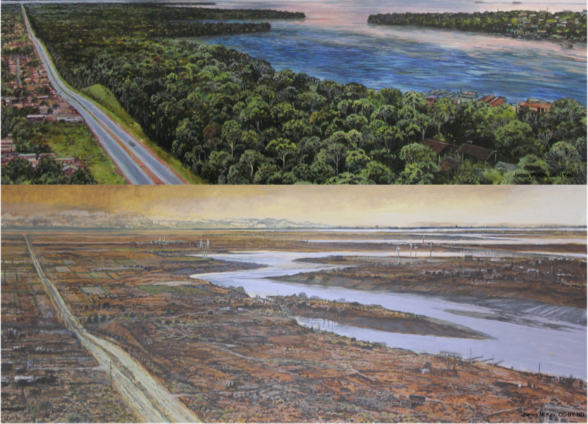By 2500 earth could be alien to humans
To fully grasp and plan for climate impacts under any scenario, researchers and policymakers must look well beyond the 2100 benchmark.

[Feb 16, 2022: Shirley Cardenas, McGill University]
The top image is a present-day landscape. The bottom image considers the year 2500 and shows a barren landscape and low water level resulting from vegetation decline, with sparse or degraded infrastructure and minimal human activity. (CREDIT: James McKay, CC BY-ND)
To fully grasp and plan for climate impacts under any scenario, researchers and policymakers must look well beyond the 2100 benchmark. Unless CO2 emissions drop significantly, global warming by 2500 will make the Amazon barren, the American Midwest tropical, and India too hot to live in, according to a team of international scientists.
“We need to envision the Earth our children and grandchildren may face, and what we can do now to make it just and liveable for them,” says Christopher Lyon, a Postdoctoral Researcher under the supervision of Professor Elena Bennett at McGill University. “If we fail to meet the Paris Agreement goals, and emissions keep rising, many places in the world will dramatically change.”
The scientists ran global climate model projections based on time dependent projections of atmospheric greenhouse gas concentrations for low, medium, and high mitigation scenarios up to the year 2500. Their findings, published in Global Change Biology, reveal an Earth that is alien to humans.
The top image is a busy agrarian village scene of rice planting, livestock use, and social life. The second is a present-day scene showing the mix of traditional rice farming and modern infrastructure present in many areas of the Global South. The bottom image shows a future of heat-adaptive technologies including robotic agriculture and green buildings with minimal human presence due to the need for personal protective equipment. (CREDIT: James McKay, CC BY-ND)
Vegetation moves to the poles
Under low and medium mitigation scenarios – which do not meet the Paris Agreement goal to limit global warming to well below 2 degrees Celsius – vegetation and the best crop-growing areas may move towards the poles. The area suitable for some crops would also be reduced. Places with long histories of cultural and ecosystem richness, like the Amazon Basin, may become barren.
Tropical regions uninhabitable
They also found that heat stress may reach fatal levels for humans in tropical regions that are highly populated. Even under high-mitigation scenarios, the team found that the sea level keeps rising due to expanding and mixing water in warming oceans.
“These projections point to the potential magnitude of climate upheaval on longer time scales and fall within the range of assessments made by others,” says Lyon.
Looking beyond 2100
Although many reports based on scientific research talk about the long-term impacts of climate change – such as rising levels of greenhouse gases, temperatures, and sea levels – most of them don’t look beyond the 2100 horizon. To fully grasp and plan for climate impacts under any scenario, researchers and policymakers must look well beyond the 2100 benchmark, says the team.
“The Paris Agreement, the United Nations, and the Intergovernmental Panel on Climate Change’s scientific assessment reports, all show us what we need to do before 2100 to meet our goals, and what could happen if we don’t,” says Lyon. “But this benchmark, which has been used for over 30 years, is short-sighted because people born now will only be in their 70s by 2100.”
Climate projections and the policies that depend on them, shouldn’t stop at 2100 because they cannot fully grasp the potential long-term scope of climate impacts, the scientists conclude.
About this study
"Climate change research and action must look beyond 2100" by Christopher Lyon,Erin E. Saupe,Christopher J. Smith,Daniel J. Hill,Andrew P. Beckerman,Lindsay C. Stringer,Robert Marchant,James McKay,Ariane Burke,Paul O’Higgins,Alexander M. Dunhill,Bethany J. Allen,Julien Riel-Salvatore, and Tracy Aze was published in Global Change Biology.
Note: Materials provided above by McGill University. Content may be edited for style and length.
Like these kind of feel good stories? Get the Brighter Side of News' newsletter.
Tags: #New_Discoveries, #Climate_Change, #Green_News, #CO2_Emissions, #Global_Warming, #Science, #Research, #The_Brighter_Side_of_News
Joseph Shavit
Head Science News Writer | Communicating Innovation & Discovery
Based in Los Angeles, Joseph Shavit is an accomplished science journalist, head science news writer and co-founder at The Brighter Side of News, where he translates cutting-edge discoveries into compelling stories for a broad audience. With a strong background spanning science, business, product management, media leadership, and entrepreneurship, Joseph brings a unique perspective to science communication. His expertise allows him to uncover the intersection of technological advancements and market potential, shedding light on how groundbreaking research evolves into transformative products and industries.



